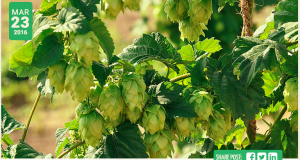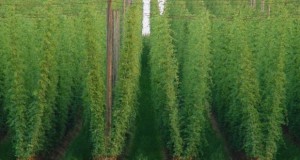By: Chris Washenberger | Beer Graphs | June 17, 2013
 IBU, in this hop-heavy world, is a number that is commonly tossed around and even more commonly misunderstood, if grasped at all. International Bittering Units are calculated numbers used to indicate bitterness in a beer. Regardless of other factors, higher numbers indicate a “hoppier” or more bitter beer.
IBU, in this hop-heavy world, is a number that is commonly tossed around and even more commonly misunderstood, if grasped at all. International Bittering Units are calculated numbers used to indicate bitterness in a beer. Regardless of other factors, higher numbers indicate a “hoppier” or more bitter beer.
Seems same simple right? Well… Sure, Bud Light runs around 5 to 10 IBU while Oskar Blues Deviant Dale’s runs around 85 IBU. That should be pretty clear overall. A Bud Light devotee (not that there’s anything wrong with that) may actually drop dead from flavor overload if we secretly switch beers on them. So can we close the book on bitterness? It says that it is “International” in the name. It must be a standardized measurement. Right?
Well, not really. Not at all, actually. It is best to take a look at bitterness and components of hops that make a beer bitter. Hops (Humulus lupulus) as we use the term are actually the reproductive flower (strobile) of a vining perennial plant. These cone-like structures are filled with tiny nodules of resin produced in the lupulin gland. This resin contains varying amounts of compounds composed mainly of alpha and beta acids as well as multiple terpenoids.
Alpha acids will be our main bittering component. Beta acids are not particularly bitter and not really soluble in beer. (It is worth noting that a few of their oxidation products are bitter and may give us calculation problems.) Terpenes or terpenoids are volatile aromatic molecules that provide the various hop aromas and flavors. Myrcene, citral and linalool are just a few examples that give resinous, fruity or citrus characteristics. These compounds do not add to the IBU calculation but still need to be considered since many mentally equate grapefruit characteristics with bitterness.
Alpha acids, when subjected to boiling during beer production, isomerize to form iso-alpha acids (IAA.) The process of isomerization changes the structure of a molecule while keeping the chemical formula of the same. The iso-alpha acids produced are bitter compounds and the more you boil a solution of alpha acids the more bitter it becomes. The traditional bitterness that we expect our in beers the results of these iso-alpha acids.
To really measure the bitterness of beer you need to make some choices. The simple choice would be to ask precisely how much iso-alpha acid is in solution. That can be determined by solid-phase extraction or analysis in high performance liquid chromatography instrument. This process will give a brewer a very accurate analysis of the flavor and aroma compounds contributed by hop additions. This is favorable because there are no real shifty variables. The controls are constant and you will find out exactly what is an example of beer. In a perfect world, each batch of beer from every brewer would be subjected to this rigorous testing. This will never happen. HPLC testing is pricey and the expertise is not available everywhere. Brewers on a small scale, generally, do not normally consider this a valuable use of time or money. Some could consider this a shame but when you are selling beer and folks are enjoying it, the precise IAA content seems frivolous.
Brewers that feel the need to present an IBU measurement use more common methods of calculating bitterness using batch averaged alpha acid content (as a percentage of weight) that is provided by the hop grower or processor. This number is then plugged into one of four common formulas with other variables that account for for things like specific gravity, boil time or malt components of the beer etc. I see a number of problems here. Foremost, calling something “international” if there are four different ways to come up with four different numbers that are supposed to tell you how bitter your beer is. Whether Tinseth, Daniels, Rager or Garetz, the four methods have a failing at the source.
Hop utilization is a concept wherein an amount of hops has an alpha acid potential that is isomerized over a period of boiling. The number provided by the hop processor is a batch average so it may not precisely represent the pounds of pellets going into a beer. It does not necessarily take into account storage time or method. Oxidization is not considered either. Ultimately, these things do not affect the quality of a beer but they do make it really sticky when acting as a variable in a formula. x does not necessarily equal x, so to speak and that makes it a bit tough to determine y.
Stan Hieronymous, in his recent treatise on hops, points out that even the formulas set up by the American Society of Brewing Chemists are actually a compromise made between the ASBC and the European Brewers Convention based on old data from the 60’s when bad storage was the norm and beta acid oxidation products made up more of the bittering compounds than they do in modern beers.
Ultimately, that leaves us with a pretty arbitrary number that supposedly indicates a level of bitterness. Hieronymus provides a list of other variables that could affect bitterness which includes pH of the brewing water and even the shape of the boiling vessel, among other things. This type of thing makes a bit tough to standardize a measurement across all beers in all of the different brewing systems worldwide.
We must also consider that bitterness itself is a description of a biological sense. Each one of us perceives it differently. An IBU of 30 is going to be different in the mouth of the beholder. There is also biological threshold that can be reached. At a certain point a damned bitter beer is just damned bitter regardless of the extra pound of hops added to it.
In measuring in analyzing beer, there are a lot of precise numbers that actually mean something and we will address these as time goes on. The only thing I can say about an IBU listed on a can or bottle is that it is definitely a number. You can presume a beer with a higher IBU number is probably more bitter than a beer with a lower number. You cannot count on it is much more than a signifier or marketing point though.
One of my favorite beer geek gags is when you hear someone expounding on IBU as an important factor in tasting or judgment of a beer or a particular brand, ask if they are basing it off of the Tinseth Or Daniels formula. That should give them enough pause so you can get the bartender’s attention.
To read the original article click here.
 Ontario Hop Growers' Association The OHGA is a not-for-profit association of hop growers, families and enthusiasts who are interested in supporting the growth of the hop industry in Ontario.
Ontario Hop Growers' Association The OHGA is a not-for-profit association of hop growers, families and enthusiasts who are interested in supporting the growth of the hop industry in Ontario.



